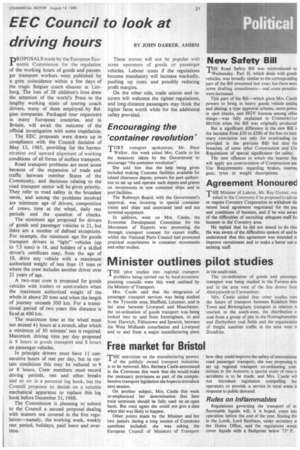EEC Council to look at driving hours
Page 23

If you've noticed an error in this article please click here to report it so we can fix it.
PROPOSALS made by the European Economic Commission for the regulation of the working hours of goods and passenger transport workers were published by a grim coincidence within a few days of the tragic Belgian coach disaster at Limburg. The loss of 28 children's lives drew the attention of the world's Press to the lengthy working stints of touring coach drivers, many of them employed. by Belgian companies. Packaged tour organizers in many European countries, and in Britain, will await the outcome of the official investigation with some trepidation.
The EEC proposals were drawn up in compliance with the Council decision of May 13, 1965, providing for the harmonization and upward alignment of working conditions of all forms of surface transport.
Road transport problems are most acute because of the expansion of trade and traffic between member States of the Community, and decisions relating to the road transport sector will be given priority. They refer to road safety in the broadest sense, and among the problems involved are minimum age of drivers, composition of crews, time at the wheel, daily rest periods and the question of checks.
The minimum age proposed for drivers of goods and passenger vehicles is 21, but thtre are a number of defined exceptions. For example, the minimum age for goods transport drivers in "light" vehicles (up to 7.5 tons) is 18, and holders of a skilled driver's certificate may, from the age of 18, drive any vehicle with a maximum authorized weight of less than 15 tons or where the crew includes another driver over 21 years of age.
A two-man crew is proposed for goods vehicles with trailers or semi-trailers when the maximum authorized weight of the whole is above 20 tons and when the length of journey exceeds 300 km. For a transitional period of two years this distance is fixed at 400 km.
The maximum time at the wheel must not exceed 44hours at a stretch, after which a minimum of 30 minutes' rest is required. Maximum driving time per day proposed is 9 hours in goods transport and 8 hours on passenger vehicles.
In principle drivers must have 11 consecutive hours of rest per day, but in certain conditions this may be reduced to 9 or 8 hours. Crew members must record driving periods, rest and other breaks and so on in a personal log book, but the Council proposes to decide on a suitable mechanical apparatus to replace this log book before December 31, 1968.
The Commission is planning to submit to the Council a second proposal dealing with matters not covered in the first regulation—namely, the working week, weekly rest period, holidays, paid leave and overtime.
These moves will not be popular with some operators of goods or passenger vehicles. Labour costs if the regulations become mandatory will increase markedly, pushing up costs and possibly reducing profit margins.
On the other side, trade unions and insurers will welcome the tighter regulations, and long-distance passengers may think the higher fares worth while for the additional safety provided.
Encouraging the 'container revolution'
TORY transport spokesman, Mr. Peter Walker, this week asked Mrs. Castle to list the measures taken by the Government to encourage "the container revolution".
She told him that the help being given included making Customs facilities available for inland clearance depots, powers for port authorities to set up and operate such depots and grants on investments in new container ships and in port facilities.
The Railways Board, with the Government's approval, was investing in special container trains and ships and associated land and sea terminal equipment.
In addition, went on Mrs. Castle, the Economic Development Committee for the Movement of Exports was promoting the through transport concept for export traffic, whilst the National Ports Council had promoted practical experiments in container movements and other studies.
New Safety Bill
THE Road Safety Bill was reintroduced or Wednesday. Part II, which deals with good: vehicles, was broadly similar to the correspondir4 part of the Bill presented last year; but there wer( some drafting amendments—and some penaltiet were increased.
This part of the Bill—which gives Mrs. Castk powers to bring in heavy goods vehicle testin2 and plating, a type approval scheme, more powei in spot checks, and HGV licences among othei things—was fully explained in COMMERCIAT MOTOR when the Bill was originally produced But a signifiCant difference in the new Bill it the increase from £50 to £200 of the fine on sum mary conviction not only for overloading (a; provided in the previous Bill) but also foi breaches of some other Construction and Us( Regulations of special significance for safety.
The new offences to which the heavier fin( will apply are contravention of Construction an Use Requirements. regarding brakes, steerirq gear, tyres or weight descriptions.
Agreement Honoured
THE Minister of Labour, Mr. Ray Gunter. vat
asked in the Commons if he proposed to advis( or require Coventry Corporation to withdraw the recent local agreement negotiated for the pa) and conditions of busmen, and if he was awart of the difficulties of recruiting adequate staff fa busmen in the Coventry area.
He replied that he did not intend to do this He was aware of the difficulties spoken of and h( understood that this agreement was intended tx improve recruitment and to make a better use o existing staff.












































































































